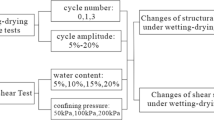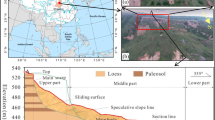Abstract
In this paper, the Malan loess is considered as the research object, through the direct shear test and electron microscope scanning test (SEM test), and based on studying the macroscopic shear deformation of loess, the formation and evolution of the shear surface of Malan loess are analyzed from the macroscopic, microscopic and granular scales, and the microscopic mechanism of the shear deformation characteristics of Malan loess is deeply revealed. The test results show that the shear strength of soil is controlled by the moisture state and the stress state, and the shear strength parameters c and φ are mainly related to the moisture state. The dry density highly affects the cohesion, but has a small influence on the internal friction angle. On the macroscopic level, the larger the vertical load, the smaller the shear surface roughness. In addition, the higher the water content, the higher the flatness of the shear surface. On the microscopic level, some skeleton particles near the shear surface are damaged and rearranged along the shearing direction during the shearing process, and some surface scratches appear. On the granular level, the basic shearing structural functional units mainly include the “core–coat” covering structure and the aggregate structure, and the performance of the basic structural functional units is related to the moisture state and the stress state. The results and conclusions obtained in this study have an important reference significance for the in-depth understanding of the strength characteristics and microscopic mechanisms of loess as well as similar soil materials.



















Similar content being viewed by others
Data availability
Some or all data that support the findings of this study are available from the corresponding author upon reasonable request.
References
Barden L, Mcgown A, Collins K (1974) The collapse mechanism in partly saturated soil. Int J Rock Mech Min Sci Geomech Abstracts 11(01):49–60. https://doi.org/10.1016/0148-9062(74)92233-5
Cao XP, Li BP (2004) Characteristics of water sensitivity of Malan loess. Gansu Sci Technol 20(11):85–87. https://doi.org/10.3969/j.issn.1000-0952.2004.11.041
Chen HM, Bang FQ, Liu XW (2006) Relationship between water content ω and unsaturated soil shear strength indices c and Ф. J Hefei Univ Technol (natural Science) 29(06):736–738+746. https://doi.org/10.3969/j.issn.1003-5060.2006.06.024
Dang J, Li J (2001) The structural strength and shear strength of unsaturated loess. J Hydraulic Eng 32(07):79–84. https://doi.org/10.13243/j.cnki.slxb.2001.07.014
Fang XW, Shen CN, Wang L et al (2013) Research on microstructure of Q2 loess before and after wetting. Rock Soil Mech 34(05):1319–1324. https://doi.org/10.16285/j.rsm.2013.05.040
Fang J, Zhu JA, Meng L (2019) Water-sensitive properties of shear strength of Bijie red clay under direct shear testing. IOP Conf Ser 252(05):052083(4pp). https://doi.org/10.1088/1755-1315/252/5/052083
Frost JD, Jang DJ (2000) Evolution of sand Microstructure during shear. J Geotech Geoenviron Eng 126(02):116–130. https://doi.org/10.1061/(ASCE)1090-0241(2000)126:2(116)
Gao GR (1980) Microstructure classification and collapsibility of loess. Sci China 12:1203–1208. https://doi.org/10.1360/za1980-10-12-1203
Gibo S, Egashira K, Ohtsubo M (1987) Residual strength of smectite-dominated soils from the Kamenose landslide in Japan. Can Geotech J 24(03):456–462. https://doi.org/10.1139/t87-057
Hao YZ (2020) Mechanical properties of compacted loess considering the structure change and effect of drying and wetting cycle. Xi’an Univ Architect Technol. https://doi.org/10.1139/t87-057
Hao ZT, Li XA, Gao RR et al (2023) Experimental study of the effect of bound water on the shear strength and structural units of Malan loess. Quart J Eng Geol Hydrogeol. https://doi.org/10.1144/QJEGH2021-168
He L (2014) Impact of mineralogical composition and water chemistry on the shear strength of clay and its application. Dissertation, China University of Geosciences (Beijing)
Hicher PY, Wahyudi H, Tessier D (1994) Microstructural analysis of strain localisation in clay. Comput Geotech 16(03):205–222. https://doi.org/10.1016/0266-352X(94)90002-7
Hu R, Yeung M, Lee C et al (2001) Mechanical behavior and microstructural variation of loess under dynamic compaction. Eng Geol 59(03):203–217. https://doi.org/10.1016/S0013-7952(00)00074-0
Jiang DJ, Frost JD (2000) Use of image analysis to study the microstructure of a failed sand specimen. Can Geotech J 37(05):1141–1149. https://doi.org/10.1139/cgj-37-5-1141
Jiang MJ, Shen ZJ (1998) Microscopic analysis of shear band in structured clay. Chin J Geotech Eng 20(02):102–108
Jiang MJ, Zhang FG, Hu HJ et al (2014) Structural characterization of natural loess and remolded loess under triaxial tests. Eng Geol 181:249–260. https://doi.org/10.1016/j.enggeo.2014.07.021
Jing HJ, Zhang B (2004) Loess subgrade strength law. J Traffic Transport Eng 4(02):14–18. https://doi.org/10.3321/j.issn:1671-1637.2004.02.004
Li BX, Miao TD (2006) Research on water sensitivity of loess shear strength. Chin J Rock Mech Eng 25(05):1003–1008. https://doi.org/10.3321/j.issn:1000-6915.2006.05.022
Li ZP, Zhang M, Zhao HL (2001) The experiment study on unsaturated soil strength considering the influence of different water content. West-China Explor Eng 13(04):1–3. https://doi.org/10.3969/j.issn.1004-5716.2001.04.001
Li P, Xie WL, Pak R et al (2018a) Microstructural evolution of loess soils from the Loess Plateau of China. CATENA 173:276–288. https://doi.org/10.1016/j.catena.2018.10.006
Li XA, Li LC, Song YX et al (2018b) Characterization of the mechanisms underlying loess collapsibility for land-creation project in Shaanxi Province, China—a study from a micro perspective. Eng Geol 249:77–88. https://doi.org/10.1016/j.enggeo.2018.12.024
Liang Y, Xing XL, Li TL et al (2012) Study of the anisotropic permeability and mechanism of Q3 loess. Rock Soil Mech 33(05):1313–1318. https://doi.org/10.16285/j.rsm.2012.05.005
Liu DS (1985) Loess and environment. Science press, Beijing
Liu D, Chen XP (2013) Microscopic observation and analysis of ring shear surface of slip zone soil. Chin J Rock Mech Eng 32(09):1827–1834. https://doi.org/10.3969/j.issn.1000-6915.2013.09.014
Liu C, Ding L (2002) Strength characteristics of unsaturated loess based on general tri-axial test. Geol Explor 38(05):89–91. https://doi.org/10.3969/j.issn.0495-5331.2002.05.020
Liu XY, Fan S, Dou YM et al (2006) Experiment study on the relationship between water content and shear strength parameters of unsaturated soil in Hebei province. J Hebei Univ Technol 35(03):96–99. https://doi.org/10.14081/j.cnki.hgdxb.2006.03.020
Liu MF, Yao YP, Kong DQ (2008) The experimental study of saturated structural K0 consolidated loess. J xi’an Univ Architect Technol (natural Science Edition) 40(02):238–242+248. https://doi.org/10.3969/j.issn.1006-7930.2008.02.015
Liu Z, Liu FY, Ma FL et al (2016) Collapsibility, composition, and microstructure of loess in China. Can Geotech J 53(04):673–686. https://doi.org/10.1139/cgj-2015-0285
Liu D (2014) Analysis of the progressive failure of slope based on shear strength character of slip zone soils. Dissertation, Jinan University.
Liu JY (2018) Experimental study on air permeability and microcosmic mechanism of Malan loess. Chang’an University, Xi’an, China (CNKI:CDMD:2.1018.792326)
Mi HZ, Li RM, Niu JX (2006) The influence of water content on shear strength characteristics of Lanzhou intact loess. J Gansu Sci 18(01):78–81. https://doi.org/10.16468/j.cnki.issn1004-0366.2006.01.020
Pang XQ, Jiao LJ (2018) Study on shear damage mechanism and constitutive model of undisturbed Q3 loess. J Highway Transport Res Develop 35(04):21–26+39. https://doi.org/10.3969/j.issn.1002-0268.2018.04.003
Shi B (1996) Quantitative assessment of changes of microstructure for clay soil in the process of compaction. Chin J Geotechn Eng 18(04):60–65 (CNKI:SUN:YTGC.0.1996-04-008)
Terzaghi KT (1943) Theoretical soil mechanics. John Wiley & Sons. Inc, New York
Torabi A, Braathen A, Cuisiat F et al (2007) Shear zones in porous sand: Insights from ring-shear experiments and naturally deformed sandstones. Tectonophysics 437(1–4):37–50. https://doi.org/10.1016/j.tecto.2007.02.018
Wang YY (1990) Structural characteristics and physical and mechanical properties of loess in China. Science press, Beijing
Wang LM, Deng J, Huang Y (2007) Quantitative analysis of microstructure of loess seismic subsidence. Chin J Rock Mech Eng 192(S1):3025–3031. https://doi.org/10.3321/j.issn:1000-6915.2007.z1.066
Wen BP, Yan YJ (2014) Influence of structure on shear characteristics of the unsaturated loess in Lanzhou, China. Eng Geol 168:46–58. https://doi.org/10.3321/j.issn:1000-6915.2007.z1.066
Xie WL, Li P, Zhang MS et al (2018) Collapse behavior and microstructural evolution of loess soils from the Loess Plateau of China. J Mt Sci 15(08):1642–1657. https://doi.org/10.1007/s11629-018-5006-2
Xu YF (2018) Theory of shear strength of granular materials based on particle breakage. Chin J Geotech Eng 40(07):1171–1179. https://doi.org/10.11779/CJGE201807002
Xu LF, Zhang AJ, Zhang YQ et al (2013) Strength characteristics of loess with different calcium carbonate contents. Yellow River 35:135–138. https://doi.org/10.3969/j.issn.1000-1379.2013.09.045
Yan YJ (2013) Control mechanism of structure in shear characteristics of the unsaturated loess soils. Dissertation, China University of Geosciences (Beijing)
Yang Q, Zhang HZ, Luan MT (2004) Testing study on shear strength of unsaturated expansive soils. Chin J Rock Mech Eng 23(03):420–425. https://doi.org/10.3321/j.issn:1000-6915.2004.03.011
Yu H, Qin CZ, Zhu SD et al (2022) Theoretical analysis of shear strength of deep-sea energy soil. J Yangtze River Sci Res Inst 39(05):119–124+131. https://doi.org/10.11988/ckyyb.20210037
Yuan WN, Fan W, Jiang CC et al (2019) Experimental study on the shear behavior of loess and paleosol based on ring shear tests. Eng Geol 250:11–20. https://doi.org/10.1016/j.enggeo.2019.01.007
Zhang MH, Xie YL, Liu BJ (2006) Analysis of shear strength characteristics of loess during moistening process. Rock Soil Mech 27(07):1195–1200. https://doi.org/10.1016/10.16285/j.rsm.2006.07.036
Zhang ZQ, Jing YL, Kong DQ (2016) Experimental study on direct shear strength of compacted loess. Railw Eng 12:69–71. https://doi.org/10.3969/j.issn.1003-1995.2016.12.19
Zhu ZB, Wang XG, Zhu RS et al (2021) Ring shear test on the shear characteristics of sliding zone soil of loess in Heifangtai, Gansu. J Arid Land Resour Environ 35(05):144–150. https://doi.org/10.13448/j.cnki.jalre.2021.140
Acknowledgements
This research is supported by the National Natural Science Foundation of China (Grant No. Grant Nos. 42230712, 41572264, 41877225).
Author information
Authors and Affiliations
Contributions
Jing Zhang: conceptualization, methodology, data collection and analysis, writing-original draft, writing-review & editing, visualization. Xi-An Li: project administration, funding acquisition, proofread & review. Bingquan Zhou: data collection. Haonan Lei: material preparation. Yutao Zhang: proofread & review, data collection. Jinduo Yang: proofread & review, software. Meile Bi: proofread & review. All authors read and approved the final manuscript.
Corresponding author
Ethics declarations
Competing interests
The authors declare no competing interests.
Conflict of interest
All co-authors have seen and agree with the contents and revision of the manuscript and the authors declare that they have no conflicts of interest to disclose.
Additional information
Publisher's Note
Springer Nature remains neutral with regard to jurisdictional claims in published maps and institutional affiliations.
Rights and permissions
Springer Nature or its licensor (e.g. a society or other partner) holds exclusive rights to this article under a publishing agreement with the author(s) or other rightsholder(s); author self-archiving of the accepted manuscript version of this article is solely governed by the terms of such publishing agreement and applicable law.
About this article
Cite this article
Zhang, J., Li, XA., Zhou, B. et al. Experimental study on the shear strength influencing factors and shear surface characteristics of Malan loess. Environ Earth Sci 83, 141 (2024). https://doi.org/10.1007/s12665-024-11446-z
Received:
Accepted:
Published:
DOI: https://doi.org/10.1007/s12665-024-11446-z




